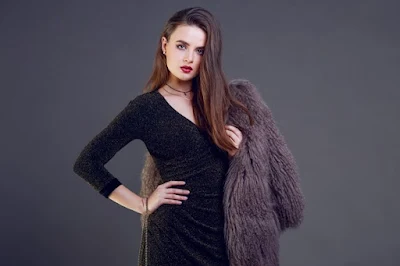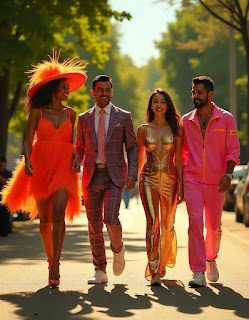Fashion Modeling
Introduction
Fashion modeling is a popular career where individuals showcase clothing and accessories for designers, brands, and stores. Models walk on runways during fashion shows and appear in photoshoots for magazines, advertisements, and online platforms. They play a crucial role in presenting the latest fashion trends and influencing public styles.
To become a fashion model, one needs to have a unique look, confidence, and the ability to pose naturally. Physical requirements can vary, but height, body proportions, and skin clarity are often important. Many models start their careers by building a portfolio with professional photos and seeking representation from modeling agencies.
Fashion modeling can be glamorous but also demanding. Models often travel, work long hours, and maintain strict beauty routines. Despite the challenges, many find it rewarding to work in a dynamic industry that celebrates creativity and style.T
The Evolution of Fashion Modeling
Fashion modeling has come a long way since its early days. In the beginning, models were mostly used to showcase clothing in a straightforward manner. They would stand still, letting the garments speak for themselves. Over time, this changed. In the 1950s and 60s, fashion modeling began to evolve into a more dynamic profession. Models like Twiggy and Jean Shrimpton became household names. They brought a new level of personality and flair to the runway. This era marked the beginning of the model as a celebrity.
In the 1970s and 80s, the industry continued to grow. Supermodels like Cindy Crawford, Naomi Campbell, and Claudia Schiffer emerged. They were not just models; they were global icons. These supermodels graced the covers of magazines and walked the runways of top designers. Their influence extended beyond fashion. They became symbols of beauty and style, setting trends that people around the world followed.
Today, fashion modeling is more diverse than ever. Models come from all backgrounds and body types. This inclusivity reflects a broader change in society's understanding of beauty. Social media has also transformed the industry. Models can now connect directly with their fans, building personal brands. Instagram, TikTok, and other platforms have given rise to a new generation of models. These digital influencers often have millions of followers. They play a significant role in shaping fashion trends. The evolution of fashion modeling continues as the industry adapts to new technologies and cultural shifts.
The Role of a Fashion Model
A fashion model's job is much more than just wearing clothes. They are storytellers, using their bodies and expressions to bring designers' visions to life. During photo shoots, models work closely with photographers, makeup artists, and stylists. They must understand how to pose and move in ways that best showcase the clothing. This requires a deep understanding of angles, lighting, and the overall mood of the shoot. A successful model knows how to convey emotion and style through subtle movements.
On the runway, the role of a fashion model is equally demanding. Walking in high heels and intricate outfits takes practice and skill. Models must maintain perfect posture and a confident walk. They need to make the clothing look as good as possible, capturing the audience's attention. Runway shows are often fast-paced and high-pressure environments. Models must be able to adapt quickly, changing outfits in seconds and staying composed under intense scrutiny.
Beyond the technical skills, a fashion model must also be adaptable and professional. They often work long hours and must travel frequently. The ability to maintain a positive attitude and work well with a variety of people is crucial. Models must also take care of their physical and mental health. The demands of the job can be challenging, but a strong support system and self-care routine can make a big difference. Overall, being a fashion model is about more than just looks; it requires dedication, skill, and resilience.
The Impact of Fashion Modeling on Society
Fashion modeling has a significant impact on society. Models are often seen as the epitome of beauty and style. They influence trends and set standards for what is considered fashionable. When a model wears a particular outfit or style, it often becomes popular among the public. This can be seen in the way people dress, style their hair, and even in the products they buy. Fashion models help to shape the cultural zeitgeist, reflecting and setting trends.
The influence of fashion modeling extends beyond just clothing. Models also play a role in promoting body positivity and diversity. In recent years, there has been a push for more inclusive representation in the industry. Models of different sizes, ethnicities, and ages are now being celebrated. This shift helps to challenge and change traditional beauty standards. It sends a powerful message that beauty comes in many forms. This inclusivity is important for promoting self-acceptance and confidence among all people.
However, the industry also faces criticism for promoting unrealistic standards of beauty. The pressure to maintain a certain look can lead to issues such as eating disorders and low self-esteem. It is important for the fashion industry to continue to evolve and promote healthy, diverse representations of beauty. By doing so, fashion modeling can have a positive impact on society. It can inspire creativity, foster self-expression, and encourage a more inclusive understanding of beauty. The ongoing dialogue about these issues highlights the important role that fashion modeling plays in shaping cultural attitudes and values.
How to Become a Fashion Model?
1. Preparing for a Career in Fashion Modeling
Becoming a fashion model requires a combination of physical attributes, skills, and preparation. The first step is understanding the industry's requirements. Most fashion models are tall, with women generally being at least 5'8" and men at least 6'0". Maintaining a healthy body weight and physique is crucial, as the industry often demands specific measurements. Regular exercise and a balanced diet can help you stay in shape. However, it's also essential to embrace a healthy lifestyle without resorting to unhealthy habits.
Next, develop your modeling skills. Posing in front of a mirror can help you understand your best angles and expressions. Practicing different walks, especially the runway walk, is also beneficial. Watching fashion shows and observing professional models can give you insights into their techniques and styles. Confidence is key, so work on building your self-esteem. Modeling is not just about looks; it’s about how you carry yourself and express different emotions through your poses and expressions.
Building a strong portfolio is a critical step. This includes professional photographs that showcase your versatility and range. Consider working with a reputable photographer who has experience in fashion photography. Your portfolio should highlight various looks, including casual, formal, and high fashion. Additionally, create a composite card, which is a business card for models, featuring some of your best photos and your measurements. This will be your primary marketing tool when approaching agencies and potential clients.
2. Entering the Fashion Modeling Industry
Once you're prepared, the next step is to start approaching modeling agencies. Research agencies that have a good reputation and represent models with similar looks to yours. Many agencies have online submission forms where you can send your portfolio and composite card. If you prefer a more personal approach, consider attending open casting calls, which are held by agencies to discover new talent. Always be professional and courteous, as first impressions are vital in this industry.
Networking is another crucial aspect of becoming a fashion model. Attend fashion shows, industry events, and social gatherings where you can meet industry professionals. Building relationships with photographers, designers, and other models can open doors to new opportunities. Social media is also a powerful tool for aspiring models. Platforms like Instagram can showcase your portfolio to a wider audience. Be active, post regularly, and engage with followers to increase your visibility.
Lastly, consider getting professional training. Modeling schools offer courses that teach posing, walking, and other essential skills. They also provide knowledge about the industry, including how to handle contracts and navigate castings. While not mandatory, these schools can provide a competitive edge. Remember, rejection is a part of the journey. Not every agency or client will see your potential, but perseverance and resilience are key. Keep improving your skills, maintaining your portfolio, and networking until you find the right opportunities.
Conclusion
Fashion modeling is a dynamic and exciting industry. It blends creativity, art, and business. Models play a crucial role in showcasing new trends and designs. This career requires dedication, discipline, and professionalism. Success depends on a model's ability to adapt, maintain their appearance, and network effectively. While it can be glamorous, it also demands hard work and resilience. Aspiring models must be prepared for both the challenges and rewards of this competitive field. With the right mindset and preparation, a career in fashion modeling can be very fulfilling. It offers opportunities to travel, meet diverse people, and be part of the ever-evolving world of fashion.
FAQs
1. What is fashion modeling?
Fashion modeling involves showcasing clothing and accessories for designers, brands, and retailers.
2. What do I need to become a model?
You need good physical appearance, confidence, and the ability to pose and walk well.
3. Is modeling a full-time job?
It can be both full-time or part-time, depending on the assignments and demand.
4. Do models need formal training?
While not mandatory, training can help improve skills and increase opportunities.
5. What are the benefits of being a model?
Benefits include traveling, meeting new people, and working in a creative environment.







Comments
Post a Comment